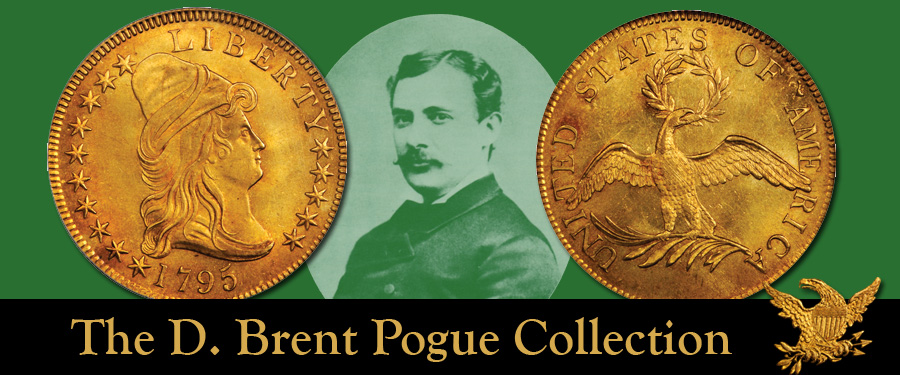
A marvelous MS-66+ (PCGS) 1795 eagle, 13 leaves, the first year of the denomination, is featured now. But first, this:
The Pogue Collection Sales
Welcome to our second series of weekly messages about the D. Brent Pogue Collection. Numismatic history was made on May 19 in New York City at Sotheby’s, our partners in the sale, where 128 coins sold for over $25 million, with the results topping the total of the high estimates. Bidders from all over the world competed to acquire some of the very finest early American coins ever to cross the auction block. The Part I sale and catalog are now a permanent part of the numismatic record books.
Part II of the D. Brent Pogue Collection will cross the block at Sotheby’s, New York City, on Wednesday evening, September 30. This catalog will feature Capped Bust half dollars from 1807 to 1822 (including the rare 1817/4), early silver dollars beginning with a Superb Gem 1794 and continuing to include several spectacular 1795 coins, quarter eagles from 1821 through the end of the Classic Head series in 1839 (including incredible gems), $5 gold half eagles from 1795 to 1807, and $10 gold eagles from 1795 to 1804. As you read these words, research and cataloging is ongoing.
The 1795 BD-4 Eagle
Starting our series of articles on the D. Brent Pogue Collection Part II sale is a truly memorable 1795 eagle, Bass Dannreuther-4, 13 leaves on the palm branch. Graded MS-66+ by PCGS, it is the only coin at this rarefied level.
When we cataloged this coin for our Garrett Collection Part III sale in October 1980 we were excited about it, and today in 2015 we are equally enthusiastic. We called it “A virtually flawless piece. The finest coin by far we have ever seen of this issue. Well centered, exceedingly well struck, without adjustment marks, and a gem in every respect. We doubt if a finer coin does or theoretically could exist! A very exciting coin, one which will surely capture the imagination of connoisseurs. One of the most important coins in the Garrett Collection.”
T. Harrison Garrett was a connoisseur par excellence. Today nearly all coins that are traced to his ownership or to his sons, Robert Garrett and Ambassador John Work Garrett, are among the finest of their kind. If you’d like to learn all about the Garretts, track down a copy of The History of United States Coins as Illustrated by the Garrett Collection, published in 1979. The first printing of 4,000 copies sold out in a week or so. Other printings followed, totaling about 15,000.
Prior to its acquisition by T. Harrison Garrett, this eagle was included in a Bangs & Co. sale in New York City in February 1880. That firm conducted an auction room in which many products were sold. Especially important were wholesale quantities of books. Unlike today, publishers would print thousands of books and then offer them at auction to wholesale buyers, the standard trade practice. Bangs & Co. also sold antiques, art, and other objects and was a venue for sales cataloged by coin dealers of the time whose names were mentioned. In other instances the writers of the descriptions remained anonymous. Descriptions in most catalogs were bare bones—more in the nature of simple listings.
Today the study of early auction catalogs, magazines, and price lists is a dynamic specialty in itself. There is much to be found. The Numismatic Bibliomania Society is a focal point for such activity, and its Internet feature by Wayne Homren, eSylum, is published every Sunday evening, available free of charge. Building a working library of numismatic books adds much to the joy of collecting, and we recommend that everyone do this.
Next week: the classic 1817/4 Capped Bust half dollar.





